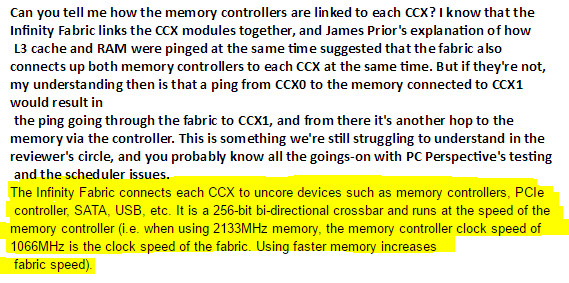https://www.techpowerup.com/231585/a...t-memory-speed
Memory clock speeds will go a long way in improving the performance of an AMD Ryzen processor, according to new information by the company, which reveals that Infinity Fabric, the high-bandwidth interconnect used to connect the two quad-core complexes (CCXs) on 6-core and 8-core Ryzen processors with other uncore components, such as the PCIe root-complex, and the integrated southbridge; is synced with the memory clock. AMD made this revelation in a response to a question posed by Reddit user CataclysmZA.
Infinity Fabric, a successor to HyperTransport, is AMD's latest interconnect technology that connects the various components on the Ryzen "Summit Ridge" processor, and on the upcoming "Vega" GPU family. According to AMD, it is a 256-bit wide bi-directional crossbar. Think of it as town-square for the chip, where tagged data and instructions change hands between the various components. Within the CCX, the L3 cache performs some inter-core connectivity. The speed of the Infinity Fabric crossbar on a "Summit Ridge" Ryzen processor is determined by the memory clock. When paired with DDR4-2133 memory, for example, the crossbar ticks at 1066 MHz (SDR, actual clock). Using faster memory, according to AMD, hence has a direct impact on the bandwidth of this interconnect.






 Reply With Quote
Reply With Quote





Bookmarks